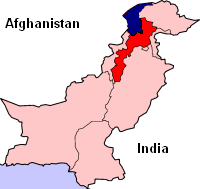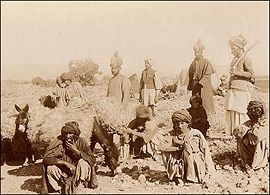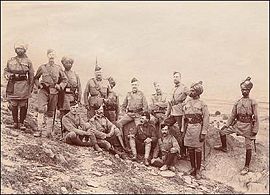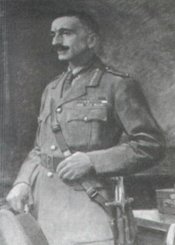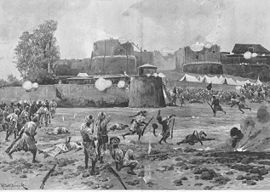Siege of Malakand
| Siege of Malakand | |||||||||
|---|---|---|---|---|---|---|---|---|---|
| Part of the Anglo-Afghan wars | |||||||||
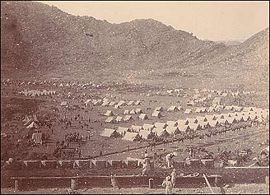 South Malakand Camp, August 1897 | |||||||||
| |||||||||
| Combatants | |||||||||
| پشتون Pashtun tribes | |||||||||
| Commanders | |||||||||
| William Hope Meiklejohn, Sir Bindon Blood |
Fakir Saidullah[1] | ||||||||
| Strength | |||||||||
| 10,630 on July 26 1897[2] | 10,000[3] | ||||||||
| Casualties | |||||||||
| 173 killed and wounded in the Malakand camps,[4][5] 33 killed and wounded at Chakdara,[6] 206 killed and wounded in total |
At least 2,000[7] | ||||||||
The Siege of Malakand took place between July 26–August 2, 1897, constituting a siege of the British garrison in the Malakand region of modern day Pakistan's North West Frontier Province.[8] The British faced a force of Pashtun tribesmen whose tribal lands had been bisected by the Durand Line,[9] the 1,519 mile (2,445 km) border between Afghanistan and British India drawn up at the end of the Anglo-Afghan wars to help hold the Russian Empire's spread of influence towards the Indian subcontinent.
The unrest caused by that division of the Pashtun lands led to the rise of Saidullah, a Pashtun fakir who led an army of at least 10,000[3][10] against the British garrison in Malakand. Although the British forces had been divided among a number of poorly defended positions, the small garrison at the camp of Malakand South and the small fort at Chakdara both held out for six days against the much larger Pashtun army.
The siege lifted when a relief column dispatched from British positions to the south arrived in support of General William Hope Meiklejohn, commander of the British forces at Malakand South. Second lieutenant Winston Churchill, who later published his account as The Story of the Malakand Field Force: An Episode of Frontier War, accompanied that relief force.
Background
The rivalry between the British and the Russian Empires, named "The Great Game" by Arthur Conolly[11] centered on Afghanistan during the late nineteenth century. From the British perspective, Russian expansion threatened to destroy the so-called "jewel in the crown" of the British Empire, India. As the Tsar's troops in Central Asia began to subdue one Khanate after another, the British feared that Afghanistan would become a staging post for a Russian invasion.[12] Against that background the British launched the First Anglo-Afghan War in 1838, and attempted to impose a puppet regime under Shuja Shah. The regime proved short-lived, unsustainable without British military support. After the Russians sent an uninvited diplomatic mission to Kabul in 1878, tensions renewed and Britain demanded that the ruler of Afghanistan (Sher Ali Khan) accept a British diplomatic mission.[13] The mission turned back and, in retaliation, the British sent a force of 40,000 men across the border, launching the Second Anglo-Afghan War.
After reaching a virtual stalemate with those two wars against the Afghans, the British imposed the Durand Line in 1893, which divided Afghanistan and British India (now the North-West Frontier Province, Federally Administered Tribal Areas (F.A.T.A.) and Balochistan provinces of Pakistan).[14] Named after Sir Mortimer Durand,[15] the foreign secretary of the British Indian government, the Emir of Afghanistan (Abdur Rahman Khan) and the representatives of the British Empire agreed upon the division but the Afghans deeply resented it. Intended to serve as a buffer zone to inhibit the spread of Russian influence down into British India, the Afghans cared only about the division of their country.[15]
Malakand field force
The British Malakand Field Force used the town of Nowshera[16] as a base of operations. Nowshera sat south of the Kabul River "six hours by rail from Rawal Pindi".[17] Commanded by Colonel Schalch, the base served as a hospital while the normal garrison served 47 miles (76 km) away at Malakand Pass in the Malakand South Camp.[17] That force consisted of one British cavalry battalion, and one Indian cavalry and one Indian infantry battalion.[18] Winston Churchill, who would accompany the relief force as a second lieutenant and war correspondent,[19] described the camp as "…a great cup, of which the rim is broken into numerous clefts and jagged points. At the bottom of this cup is the 'crater' camp."[20] Churchill goes on to state that the British viewed the camp as purely temporary and indefensible, as a result of its cramped conditions and the domination by the surrounding heights.[20] A nearby camp, North Malakand, had been established on the plains of Khar, intended to hold the large number of troops unable to fit into the main camp. A 1,000 strong force garrisoned both of those positions for two years with little fear of attack.[20][10] Officers brought their families, and the camp held regular polo matches and shooting competitions.[21]
Outbreak of the battle
Towards 1897, news of unrest in the nearby Pashtun villages had reached the British garrisons in Malakand. Major Deane, the British political agent, noted the growing unrest within the Pashtun sepoys[22] stationed with the British. He officially distributed his warnings to senior officers on July 23, 1897; nothing more than a minor skirmish had been expected.[23][22] Rumors of a new religious leader, Saidullah the Sartor Fakir (also known as Mullah of Mastun),[24][25] arriving to "sweep away" the British and inspire a jihad,[26][27] reportedly circulated the bazaars of Malakand during July. Saidullah became known to the British as "The Great Fakir," "Mad Fakir"[28] or the "Mad Mullah,"[26] and by the Pashtuns as lewanai faqir, or simply, lewanai, meaning "god-intoxicated."[25]
On July 26, while British officers played polo near camp Malakand North, indigenous spectators watching the match learned of an approaching Pashtun force and fled. Deane informed Brigadier-General Meiklejohn, commander of the Malakand forces, that "matters had assumed a very grave aspect" and that armed Pashtuns gathered nearby. He requested reinforcements from Mardan (32 miles, 51 km, away), and Lieutenant P. Eliott-Lockhart departed at 1.30 a.m.[29] At 9.45 p.m., a final telegram arrived informing the garrison that the Fakir had passed Khar and advanced on Malakand. The telegram also stated that neither the levies nor the people would act against him, and that the Pathans covered hills to the east of the camp.[30] Shortly after, the Pathans cut the communication wire.[31]
Malakand North and Malakand South
Night of July 26/27
South camp
During the night of July 26, sometime after 10:00 p.m., a messenger arrived with word that the enemy had reached the village of Khar, three miles from Malakand.[31] A bugle call immediately sounded within the camp. Lieutenant-Colonel McRae, commanding the 45th Sikhs, two units from the 31st Punjaub Infantry, two Guns from No. 8 Mountain Battery and one Squadron from the 11th Bengal Lancers, had been expected posted to Amandara Pass, a distance of four miles, with orders to hold the position. By that time, the Pashtun column had already arrived at the South Malakand camp, surprising the British defenders,[32] and began to open fire on the garrison with muskets.[30] McRae immediately sent a small number of men under Major Taylor down a road from the "right flank" of the camp[33] to ascertain the enemy's strength and location; McRae himself later followed with his own small group. Both parties aimed for a sharp turn in the oncoming road where, flanked by gorges, they hoped to hold the attacking force.[34] McRae, with about twenty men, opened fire on the Pashtun soldiers and began a fighting withdrawal fifty paces down the road before halting in an attempt to stop the attack. Taylor received a mortal wound in the incident and quickly died;[35] McRae suffered a neck wound. Nevertheless, by 2:00 a.m. reinforcements under the command of Lieutenant Barff had enabled the British to repel the Pashtun attack.[36][35] The official dispatches of General Meiklejohn noted that:
There is no doubt that the gallant resistance made by this small body in the gorge, against vastly superior numbers, till the arrival of the rest of the regiment, saved the camp from being rushed on that side, and I cannot speak too highly of the behaviour of Lieutenant-Colonel McRae and Major Taylor on this occasion.[37]
Meanwhile, Pashtun forces had successfully assaulted the camp in three other locations, and the 24th Punjab Infantry's picket lines had been quickly overrun. Pashtun sharpshooters occupying the nearby heights inflicted casualties throughout the night, occupying the bazaar and surrounding buildings. Other units of the 24th, under Lieutenant Climo, retook the area and held it until 10:45 p.m., but fire from sharpshooters drove them back.[37] The Pashtun forces broke through in at number of other locations. Lieutenant Watling, commanding a group of British troops guarding the ammunitions stores at the Quarter Guard, had been wounded, losing the stores in the process. Meiklejohn led a small group of sappers, members of the 24th and Captain Holland, Climo from the earlier charge, and Lieutenant Manley to recapture the ammunition dump;[38] Holland and the General received wounds, and the group severely depleted as it twice failed to retake the dump, but a third attempt proved successful. Continuing crossfire from the enveloping Pashtun troops wounded a number of British officers, placing the command of the 24th with Climo. Towards 1:00 a.m. on the morning of July 27, Lieutenant Edmund William Costello rescued a wounded havildar while under fire, later receiving the Victoria Cross for his actions.[39]
As the night wore on, reinforcements arrived from a nearby British hill fort which had as yet been ignored by the Pashtun forces. At 4:15 pm, the attacking forces withdrew with their dead and wounded. The British had lost a large number of officers wounded, and recorded twenty one deaths amongst the sepoys.[40]
North camp

During the first night of the battle, the garrison at Malakand North saw little action despite being in the more exposed position,[42] and had spent much of the night firing flares and maneuvering artillery units. In response Meiklejohn ordered a reconnaissance of the vicinity, whereupon Major Gibbs, the commander of the force, encountered large groups of tribesmen in the valley. Subsequently, he eventually received orders to collect his forces and stores from Malakand North, and transfer them into the southern camp.
July 27
The last remaining forces from the now evacuated northern camp arrived in Malakand South at 8:30 am on the 27th,[43] coinciding with the arrival of more Pashtun reinforcements. In Nowshera, the 11th Bengal Lancers awoke to news describing the situation, and, together with the 8th Dogras, the 35th Sikhs, No.1 and No.7 British Mountain Batteries, they set off to relieve the besieged garrison. Meanwhile at Malakand South, elements of the 24th led by Climo, whose unit captured a Pashtun standard, repulsed fresh Pashtun attacks.
At 7:30 pm the first of the British reinforcements arrived in the form of infantry from the Corps of Guides under Lieutenant Lockhart.[44] The 45th Sikhs, supported by 100 men from the Guides and two guns, remained astride the main road into the camp, while the 31st Punjaub Infantry held the center; the 24th, under Climo, held the north edge of Malakand South. Subadar Syed Ahmed Shah of the 31st held the area around the bazaar, though leaving the market place itself unoccupied.[44] Around 8:00 p.m. the Pashtuns simultaneously attacked all the British positions where, "Many thousands of rounds were discharged" and a number of assaults repulsed.[45] Subadar Syed Ahmed Shah and his forces defended their position for several hours, the Pashtuns eventually proved successful in undermining the walls and killing the defenders. The surviving sepoys and their leader received the Order of Merit. The 24th also repelled a number of charges, with VC recipient Costello receiving a wound in the arm. Despite the constant harassment by musket fire, rifle fire and a barrage of rocks, Climo successfully led a counter-attack with two companies, pushing the attacking forces back two miles. The British records for the night of July 27 record twelve killed among the sepoy ranks, as well as the wounding of Costello.[46]
July 28
The daylight hours of July 28 saw continuous fire from the Pashtun sharpshooters established in the hills surrounding Malakand South. The garrison surgeon, Lieutenant J.H. Hugo, treated a number of British casualties including an officer from the Guides. Despite further attacks during the night of July 28/29, the British recorded only two killed from the sepoy ranks, and the severe wounding of a Lieutenant Ford. Churchill records that Hugo clamped shut Ford's bleeding artery despite being under fire.[46]
July 29–July 31
Having re-established communication on the morning of July 29, the British garrison signaled the approaching relief forces via heliograph at 8:00 a.m.—"Heavy fighting all night. Expect more tonight. What ammunition are you bringing? When may we expect you?"[47] During the day, the Pashtuns prepared for another night attack while the British destroyed the bazaar and the regions previously defended, and lost, by Subadar Syed Ahmed Shah and the men of the 31st. They also cut down trees to improve fields of fire, attracting further attention from the Pashtun sharpshooters.[48] Major Stuart Beatsen arrived at 4:00 p.m. on the 29th with the 11th Bengal Lancers who had been summoned from Nowshera two days previous. The 35th Sikhs and 38th Dogras arrived at the mouth of the pass leading to Malakand South, but after losing between 19[49] and 21[46] of their ranks through heat exhaustion, halted for relief.
At 2:00 a.m. in the morning of July 30, the Pashtuns launched another attack, during which Costello, and the Pashtun Mullah, both received wounds; the British also recorded one fatality among the sepoy contingent.[48] That evening a bayonet charge of the 45th Sikhsa repulsed a further attack. The following morning, on July 31, the remainder of the 38th Dogras and 35th Sikhs entered Malakand South under the command of Colonel Reid, bringing with them 243 mules carrying 291,600 rounds of ammunition.[50] But with their attention now drawn towards the nearby British outpost of Chakdara, attacks by the Pashtuns on Malakand South began to reduce until they ceased altogether. Churchill records a total of three British officers killed in action and ten wounded, seven sepoy officers wounded, and 153 non-commissioned officers killed and wounded during the siege of Malakand South.[48]
Relieving Chakdara
On July 28, when word of the attacks had been given, Major-General Sir Bindon Blood received [22] a division of "6800 bayonets, 700 lances or sabres, with 24 guns" with orders to hold "the Malakand, and the adjacent posts, and of operating against the neighboring tribes as may be required."[51][52] Blood arrived at Nowshera on July 31, 1897, to take command,[22] and on August 1, he learned that the Pashtun forces had turned their attention to the nearby British fort of Chakdara. A small, under-garrisoned fort with few supplies, they had been holding out with 200 men since the first attacks in Malakand began,[53] and had recently sent the signal "Help us" to the British forces.[54] Blood reached Malakand at noon on the same day.[51] While Blood and his relief force marched for Chakdara from the main camp at Nowshera, Meiklejohn set out from Malakand South with the 45th, 24th, and guns from No. 8 Battery. An advance force of Guides cavalry under Captain Baldwin[55] met with the enemy along the road, the ensuring engagement forced the British to retreat with two British officers and one sepoy officer wounded and sixteen other ranks killed or wounded.[56][57]
Following that failed attempt, Blood arrived and appointed Reid commander of the forces at Malakand South, giving command of the rescue force to Meiklejohn. The rescue column of 1,000 infantry, two squadrons from the 11th Bengal Lancers, two of the Guides cavalry, 50 sappers, two cannons and a hospital detail,[51][58] rested on the night of August 1, despite a night attack by Pashtun forces. On the following day, the relief force advanced along the road to the abandoned Malakand North to avoid fire from the Pashtun sharpshooters who still occupied the heights around the Malakand South "cup."[59] With low morale, the relief force assembled at 4:30 a.m. on August 2; using diversionary attacks, they successfully broke out of the Pashtun encirclement without loss. That led to confusion amongst the Pashtun forces, "like ants in a disturbed ant–hill" as observed Blood.[56] The 11th Bengal Lancers and the Guides cavalry went on to relieve the threatened fort at Chakdara, while the 45th Sikhs stormed nearby Pashtun positions. The British recorded thirty three casualties from the action on August 2.[6]
Aftermath

The campaigns of the Malakand Field Force continued beyond the siege of Malakand South, North, and of the Chakdara fort. Immediately after the siege, two brigades of the British garrison relocated to a new camp a few miles away to relieve the pressure in the overcrowded Malakand South. Those received only light fire during August 5 1897. On August 8, Saidullah rallied his surviving Pashtun forces and attacked the British garrison at Shabkadr fort near Peshawar. Those attacks put the continued loyalty of friendly Pashtun levies guarding the British supply lines to Chitral at risk, thus endangering the supply convoys and their small escorts.[60] In response, on August 14, the British advanced farther into Pashtun territory and engaged a force of "several thousand"[61] Pashtun tribesmen, with General Meiklejohn leading a flanking manoeuvre which split the Pashtun army in two, forcing it to pull back to Landakai.[62] The British continued to engage Pashtun tribesmen throughout the day, suffering two officers and 11 other ranks killed.[63]
The siege of Malakand constituted Winston Churchill's first experience of actual combat, which he later described in several columns for the The Daily Telegraph,[19] receiving £5 per column; he eventually compiled those articles into his first published book, The Story of the Malakand Field Force, beginning his career as a writer and politician.[64] Of the book's publication he remarked, "[it] will certainly be the most noteworthy act of my life. Up to date (of course). By its reception I shall measure the chances of my possible success in the world."[19] Of the siege of Malakand, and of the entire campaign against the Pashtun tribes in northern Pakistan, Churchill remarked that they represented a period of significant "transition."[65]
The War Office authorized the award of the clasp Malakand 1897 to the India Medal for those of the British and Indian armies who participated in this action.[66][67] The battleground remained closed to visitors and under military control since the publication of Churchill's memoirs, now the location of a Pakistani military base.[10] In 2006, the Pakistani government opened the area to foreign visitors.[10]
See also
- Bacha Khan
- Faqir of Ipi
- Pakhtunwali
- Tirah campaign
Notes
- ↑ Edwards, 263.
- ↑ Gore, 403.
- ↑ 3.0 3.1 A number of sources cite between 50,000–100,000 tribesmen as being present in the region during the siege (Wilkinson–Latham p. 20, Gore p. 405) while others give a figure of 10,000 for the actual siege (Easwaran p. 49)
- ↑ Elliott–Lockhart, 63
- ↑ Churchill, 48.
- ↑ 6.0 6.1 Churchill, 53.
- ↑ Elliott–Lockhart, 83.
- ↑ Nevill, 232.
- ↑ Lamb, 93.
- ↑ 10.0 10.1 10.2 10.3 Daily Telegraph, Pakistan asks tourists to Churchill's battlefield. Retrieved July 17, 2007.
- ↑ Hopkirk, 1.
- ↑ Hopkirk, 72.
- ↑ Curzon, 426.
- ↑ Hussain, 240.
- ↑ 15.0 15.1 Lamb, 94.
- ↑ Nevill, 232.
- ↑ 17.0 17.1 Churchill, 11.
- ↑ Elliott–Lockhart, 27.
- ↑ 19.0 19.1 19.2 Winston Churchill, WINTER 1896-97 (Age 22)—"The University of My Life." Retrieved March 17, 2007.
- ↑ 20.0 20.1 20.2 Churchill, 13.
- ↑ Churchill, 14.
- ↑ 22.0 22.1 22.2 22.3 Elliott-Lockhart, 55
- ↑ Churchill, 27
- ↑ Spain, 177
- ↑ 25.0 25.1 Beattie, 171
- ↑ 26.0 26.1 Elliott-Lockhart, 28
- ↑ Beattie, 137
- ↑ Hobday, 13.
- ↑ Churchill, 29.
- ↑ 30.0 30.1 Churchill, 31.
- ↑ 31.0 31.1 Elliott-Lockhart, 31.
- ↑ Elliott–Lockhart, 30.
- ↑ Elliott-Lockhart, 32.
- ↑ Churchill, 34.
- ↑ 35.0 35.1 Elliott-Lockhart, 33.
- ↑ Churchill, 35
- ↑ 37.0 37.1 Churchill, 36.
- ↑ Churchill, 39.
- ↑ Churchill, 40.
- ↑ Churchill, 41.
- ↑ 41.0 41.1 Ben Tottenham, Collection of photographs. Retrieved May 31, 2007.
- ↑ Elliott-Lockhart, 40.
- ↑ Churchill, 44.
- ↑ 44.0 44.1 Churchill, 45.
- ↑ Churchill, 46.
- ↑ 46.0 46.1 46.2 Churchill, 47.
- ↑ Hobday, 18
- ↑ 48.0 48.1 48.2 Churchill, 48.
- ↑ Elliott–Lockhart, 53.
- ↑ Hobday, 22.
- ↑ 51.0 51.1 51.2 Churchill, 51.
- ↑ Raugh, 222.
- ↑ Churchill, 54.
- ↑ Hobday, 32.
- ↑ Elliott–Lockhart, 56.
- ↑ 56.0 56.1 Churchill, 52.
- ↑ Hobday, 30.
- ↑ Elliott–Lockhart, 59.
- ↑ Elliott–Lockhart, 58.
- ↑ Elliott–Lockhart, 80.
- ↑ Elliott–Lockhart, 90.
- ↑ Elliott–Lockhart, 93.
- ↑ Elliott–Lockhart, 100.
- ↑ Jablonsky, 300.
- ↑ Churchill, 191.
- ↑ Medals.org, United Kingdom: India Medal 1895–1902. Retrieved May 31, 2007.
- ↑ Joslin, 30.
ReferencesISBN links support NWE through referral fees
- Beattie, Hugh. Imperial Frontier: Tribe and State in Waziristan. 2002. ISBN 0700713093.
- Churchill, Winston S. The Story Of The Malakand Field Force. 1897. ISBN 1419184105.
- Curzon, George Nathaniel. Russia in Central Asia in 1889 & the Anglo-Russian Question. 1889. OCLC 2115675.
- Edwards, David B. Heroes of the age: Moral Fault Lines on the Afghan Frontier. 1996. ISBN 0520200640.
- Elliott–Lockhart, Percy C., and Edward M. Dunmore, Earl of Alexander. A Frontier Campaign: A Narrative of the Operations of the Malakand and Buner Field Forces, 1897–1898. 1898. OCLC 4861627.
- Easwaran, Eknath. Nonviolent Soldier of Islam: Badshah Khan, a Man to Match His Mountains. 1999. ISBN 1888314001.
- Gore. The Dublin Journal of Medical Science. 1898.
- Hobday, Edmund A. P. Sketches on Service During the Indian Frontier Campaigns of 1897. 1898. OCLC 12250101.
- Hopkirk, Peter. The Great Game: On Secret Service in High Asia. 2001. ISBN 0192802321.
- Hussain, Rizwan. Pakistan And The Emergence Of Islamic Militancy In Afghanistan. 2005. ISBN 0754644340.
- Jablonsky, David Churchill and Hitler: Essays on the Political–Military Direction of Total War. 1994. ISBN 071464563X.
- Joslin, Edward Charles. The Standard Catalogue of British Orders, Decorations and Medals. 1972. ISBN 0900696486.
- Lamb, Christina. The Sewing Circles of Herat: A Personal Voyage Through Afghanistan. 2004. ISBN 0060505273.
- Nevill, Hugh Lewis. Campaigns on the North–west Frontier. 1912. ISBN 1845741870.
- Raugh, Harold E. The Victorians at War, 1815–1914: An Encyclopedia of British Military History. 2004. ISBN 1576079252.
- Spain, James William. The Pathan Borderland. 1963. ASIN B0000CR0HH.
- Wilkinson–Latham, Robert. North–west Frontier 1837–1947. 1977. ISBN 0850452759.
Credits
New World Encyclopedia writers and editors rewrote and completed the Wikipedia article in accordance with New World Encyclopedia standards. This article abides by terms of the Creative Commons CC-by-sa 3.0 License (CC-by-sa), which may be used and disseminated with proper attribution. Credit is due under the terms of this license that can reference both the New World Encyclopedia contributors and the selfless volunteer contributors of the Wikimedia Foundation. To cite this article click here for a list of acceptable citing formats.The history of earlier contributions by wikipedians is accessible to researchers here:
The history of this article since it was imported to New World Encyclopedia:
Note: Some restrictions may apply to use of individual images which are separately licensed.
